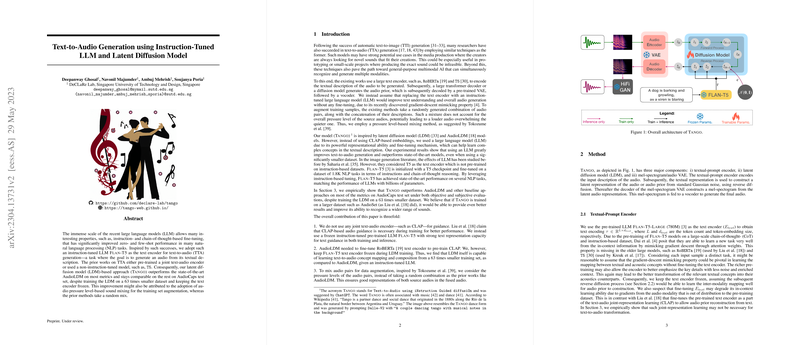Text-to-Audio Generation using Instruction-Tuned LLM and Latent Diffusion Model
The paper "Text-to-Audio Generation using Instruction-Tuned LLM and Latent Diffusion Model" presents an exploration of text-to-audio (TTA) generation leveraging an instruction-tuned LLM, specifically Flan-T5, combined with a latent diffusion model (LDM). This research shows improved performance over existing models, like AudioLDM, by introducing novel techniques in augmentation and model design, despite using a significantly smaller dataset.
Methodology
The methodology of this research employs Flan-T5 as the text encoder, taking advantage of its instruction-based fine-tuning to enhance text understanding capabilities in synthesizing audio descriptors. The research opts for a frozen text encoder, diverging from earlier methods requiring joint text-audio encoders or fine-tuning models, relying instead on the pre-trained model's innate ability to handle text inputs effectively.
A key component of this approach is the adaptation of a latent diffusion model, which constructs audio priors from standard Gaussian noise via reverse diffusion. The integration of Flan-T5 supports the inference process by using advanced text embeddings without requiring additional training layers, thus maintaining computational efficiency.
Augmentation Strategy
The researchers propose a distinctive audio mixing method, basing it on audio pressure levels rather than random selection strategies. This method is informed by human auditory perception, ensuring balanced representation of audio features when multiple sources are combined. Such a strategy aids in generating more robust training data for complex audio scenes, leading to improved model accuracy.
Results and Evaluation
The paper provides substantial evidence of the model's effectiveness through extensive experimentation on the AudioCaps dataset. The results demonstrate Tango's capacity to outperform AudioLDM and other existing models across various objective metrics, such as Frechet Audio Distance (FAD), KL divergence, and subjective evaluations. Notably, even with a dataset 63 times smaller than that used for AudioLDM, Tango achieved superior or comparable performance scores, highlighting the sample efficiency of the model.
Implications and Future Directions
The implications of this research extend to practical applications in media production, where rapid prototyping of audio from textual inputs can expedite creative processes. From a theoretical perspective, this work reinforces the potential of using instruction-tuned models to bridge modalities effectively.
Future research could explore expanding the dataset size to assess Tango's generalization capabilities across diverse audio types. Additionally, investigating other audio applications, such as super-resolution or inpainting, could provide further insights into the utility of instruction-tuned LLMs in audio tasks. Enhancing controllability in audio generation by fine-tuning Flan-T5 on more complex datasets might also improve text-to-audio alignment, a limitation acknowledged by the authors.
In conclusion, this paper contributes significantly to the understanding of leveraging LLMs for TTA tasks, offering a scalable and efficient approach that pushes the boundaries of current methodologies.
